A Reading Recovery Lesson
Every Reading Recovery lesson is different and is designed specifically by a trained teacher for an individual child based upon current needs based upon performance the day before. There is no script or sequence prescribed as each child is unique. Reading Recovery teachers design lessons to accelerate children using specific procedures and a lesson framework. All parts of the lesson framework work from the child's strengths and what is known to teach for what is still under construction.
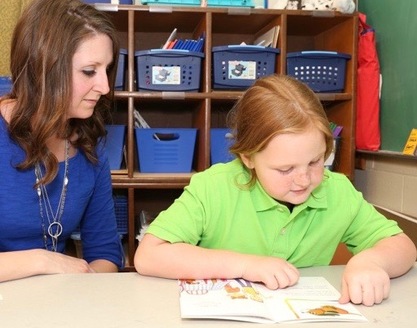
Familiar Reading:
Each day the child re-reads several familiar texts or parts of familiar texts--books successfully read in earlier lessons. Re-reading familiar texts works on fluency, comprehension, phonics and associates reading with pleasure. The teacher does little in the way of interrupting the reading but occasionally points out something important and always talks briefly about some aspect of the story.
Each day the child re-reads several familiar texts or parts of familiar texts--books successfully read in earlier lessons. Re-reading familiar texts works on fluency, comprehension, phonics and associates reading with pleasure. The teacher does little in the way of interrupting the reading but occasionally points out something important and always talks briefly about some aspect of the story.
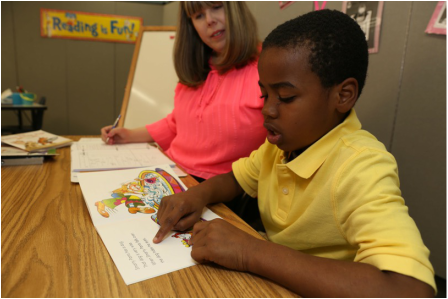
Reread of Yesterday's New Book for Assessment:
Every day the student re-reads a text that has been seen only once the previous day while the teacher carefully takes a running record to assess the child's fluency, accuracy with words, strategies for solving words, reading behaviors such as self-correcting or rereading and understanding of what is read. During the reading, the teacher is a neutral observer, feverishly capturing all the child says and does. As soon as the text is read, s/he makes a few powerful teaching points that will help propel this learner forward and reinforces helpful behaviors for future use. Running records are later analyzed for more information about next moves for this child and to assess the need to move up in levels over time.
Every day the student re-reads a text that has been seen only once the previous day while the teacher carefully takes a running record to assess the child's fluency, accuracy with words, strategies for solving words, reading behaviors such as self-correcting or rereading and understanding of what is read. During the reading, the teacher is a neutral observer, feverishly capturing all the child says and does. As soon as the text is read, s/he makes a few powerful teaching points that will help propel this learner forward and reinforces helpful behaviors for future use. Running records are later analyzed for more information about next moves for this child and to assess the need to move up in levels over time.
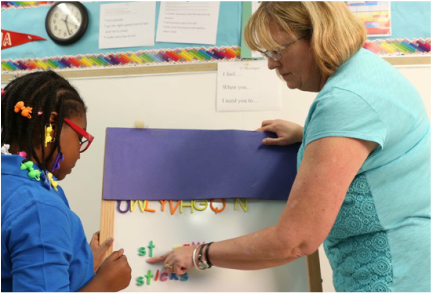
Word and letter work:
Direct instruction on how words work happens daily in Reading Recovery, either in isolation or embedded within the reading and writing of texts. Teachers watch for opportunities to support knowledge of letters, letter sounds, useful word parts, and words throughout each lesson, taking note of what is firm and what knowledge needs more attention. Word work happens on white boards, with magnetic letters, on writing pages, in books, or with other materials to engage hearing, seeing, movement and speaking. All Reading Recovery lessons are multi-sensory!
Direct instruction on how words work happens daily in Reading Recovery, either in isolation or embedded within the reading and writing of texts. Teachers watch for opportunities to support knowledge of letters, letter sounds, useful word parts, and words throughout each lesson, taking note of what is firm and what knowledge needs more attention. Word work happens on white boards, with magnetic letters, on writing pages, in books, or with other materials to engage hearing, seeing, movement and speaking. All Reading Recovery lessons are multi-sensory!
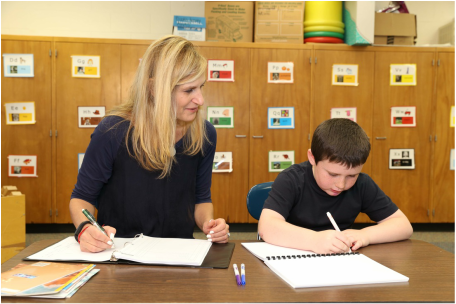
Composing and Writing A Story:
A unique feature of Reading Recovery is work on assisting the child to compose a short message of one or more sentences that is jointly constructed by the student and teacher. Sentences may be about the text, about the child's life or interests or about anything negotiated by the teacher and child. After composing (deciding what to write), the teacher assists the child in writing the message with correct conventions: spelling, spacing, punctuation and capitalization. The teacher makes decisions about what work to do on the practice page where the child is taught about any needed features they are trying to use in their writing. The teacher demonstrates or prompts the child appropriately and sometimes takes over writing the trickiest bits.
A unique feature of Reading Recovery is work on assisting the child to compose a short message of one or more sentences that is jointly constructed by the student and teacher. Sentences may be about the text, about the child's life or interests or about anything negotiated by the teacher and child. After composing (deciding what to write), the teacher assists the child in writing the message with correct conventions: spelling, spacing, punctuation and capitalization. The teacher makes decisions about what work to do on the practice page where the child is taught about any needed features they are trying to use in their writing. The teacher demonstrates or prompts the child appropriately and sometimes takes over writing the trickiest bits.
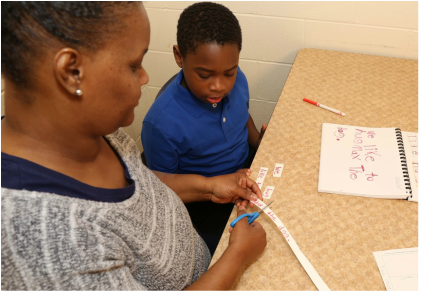
Cut-up Sentence:
Just after the writing is completed, the teacher quickly re-writes the sentence or a portion of the message onto a sentence strip. As the child watches and re-reads, the teacher cuts the message apart, usually word by word. Then the child independently re-assembles their message and must use many language features to do so--letter/sound relationships, meaning, how sentences work, etc. The sentence is then sent home in an envelope for home practice.
Just after the writing is completed, the teacher quickly re-writes the sentence or a portion of the message onto a sentence strip. As the child watches and re-reads, the teacher cuts the message apart, usually word by word. Then the child independently re-assembles their message and must use many language features to do so--letter/sound relationships, meaning, how sentences work, etc. The sentence is then sent home in an envelope for home practice.
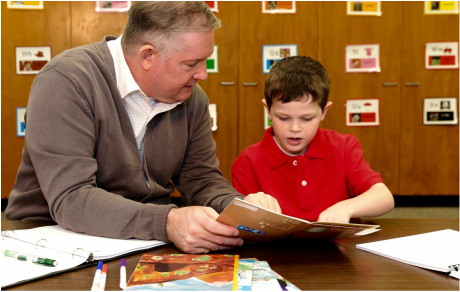
New Book Introduction & First Read:
At the end of each lesson the teacher introduces a new text that s/he has carefully selected for this child at this time. The teacher does this by talking about the meaning and looking at pictures, rehearsing a few phrases or unusual language structures that might be hard for the child and always takes time to look at one or two words, teaching about how they look and work. Then, the child reads the text while the teacher watches for teaching opportunities such as how to solve an unknown word, how to use strategies such as re-reading or checking the picture or how to use something you know from another word to solve a new word, etc. The teacher is careful not to interrupt the reading unnecessarily and observes the child's growing network of reading behaviors. This book will be read as the assessment book for a running record in the next day's lesson. Over time the teacher lifts the level of the texts, being careful to offer just enough support--not too much or too little--to help the child consolidate new learning and read more complex material.
At the end of each lesson the teacher introduces a new text that s/he has carefully selected for this child at this time. The teacher does this by talking about the meaning and looking at pictures, rehearsing a few phrases or unusual language structures that might be hard for the child and always takes time to look at one or two words, teaching about how they look and work. Then, the child reads the text while the teacher watches for teaching opportunities such as how to solve an unknown word, how to use strategies such as re-reading or checking the picture or how to use something you know from another word to solve a new word, etc. The teacher is careful not to interrupt the reading unnecessarily and observes the child's growing network of reading behaviors. This book will be read as the assessment book for a running record in the next day's lesson. Over time the teacher lifts the level of the texts, being careful to offer just enough support--not too much or too little--to help the child consolidate new learning and read more complex material.